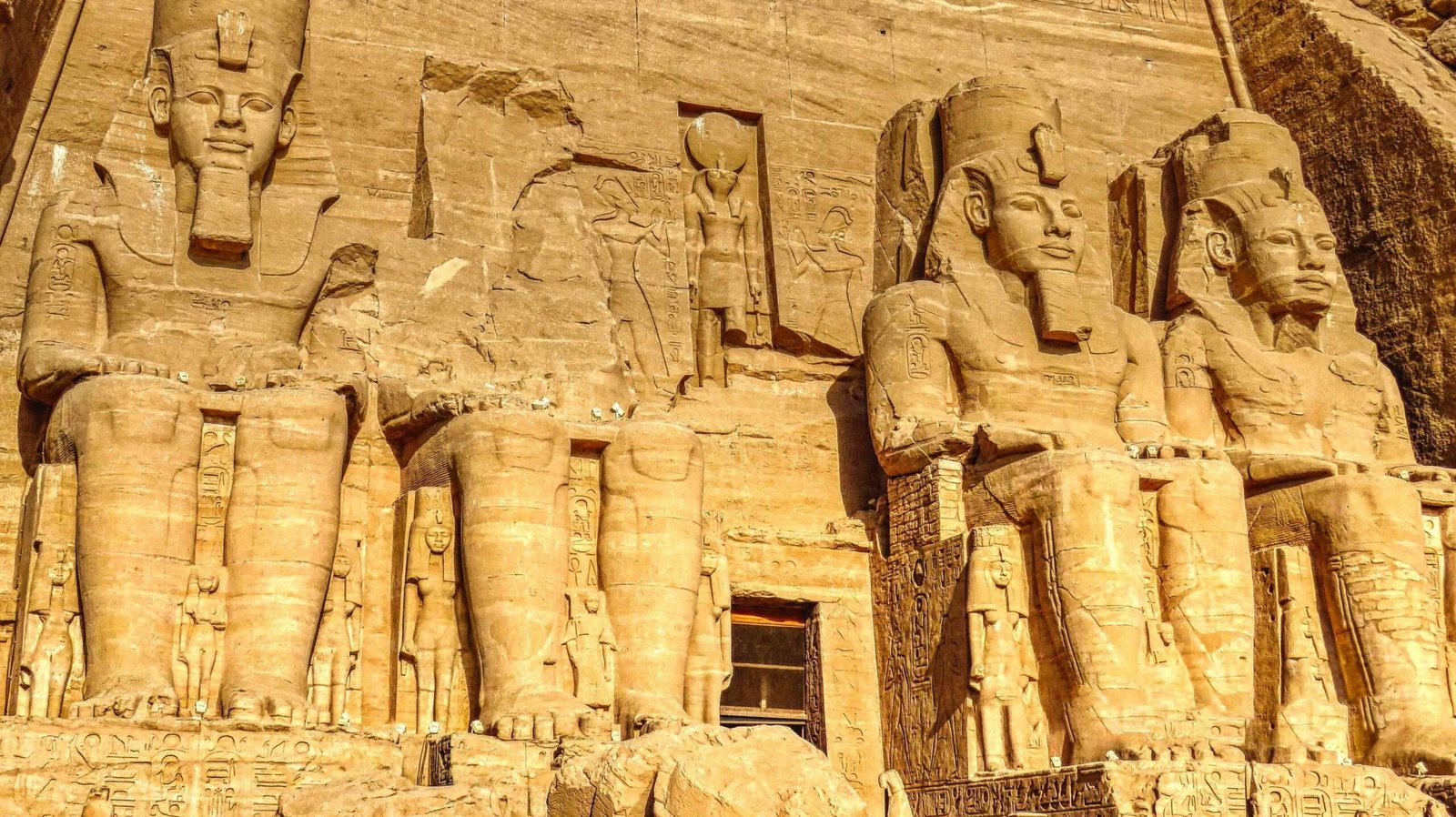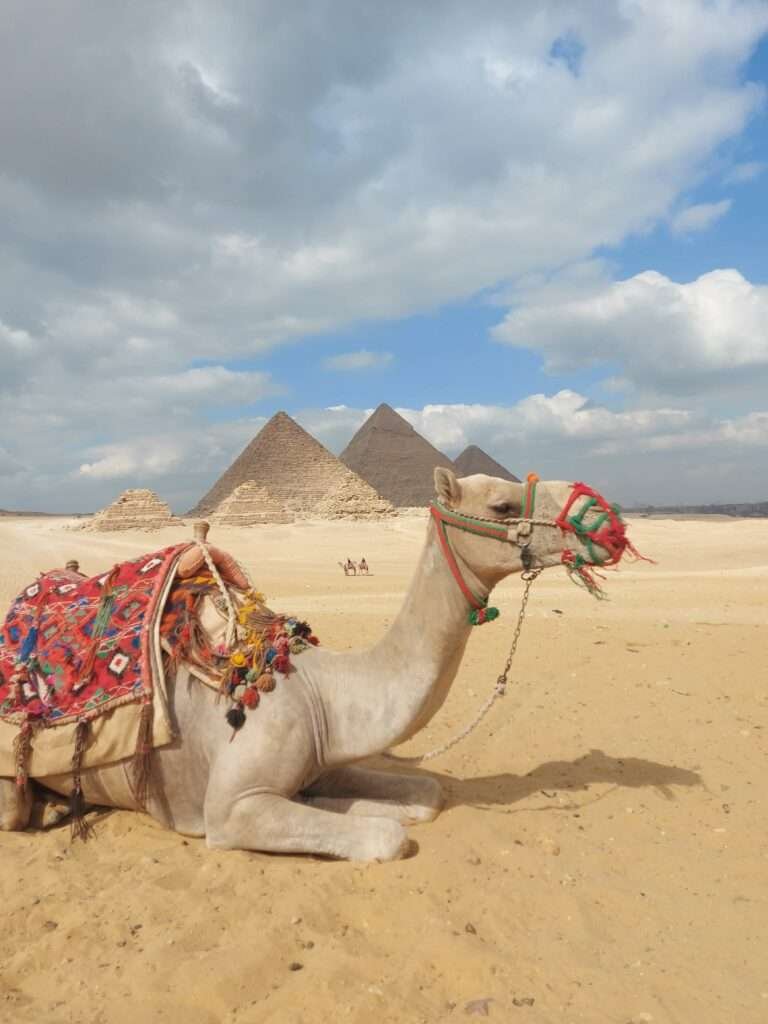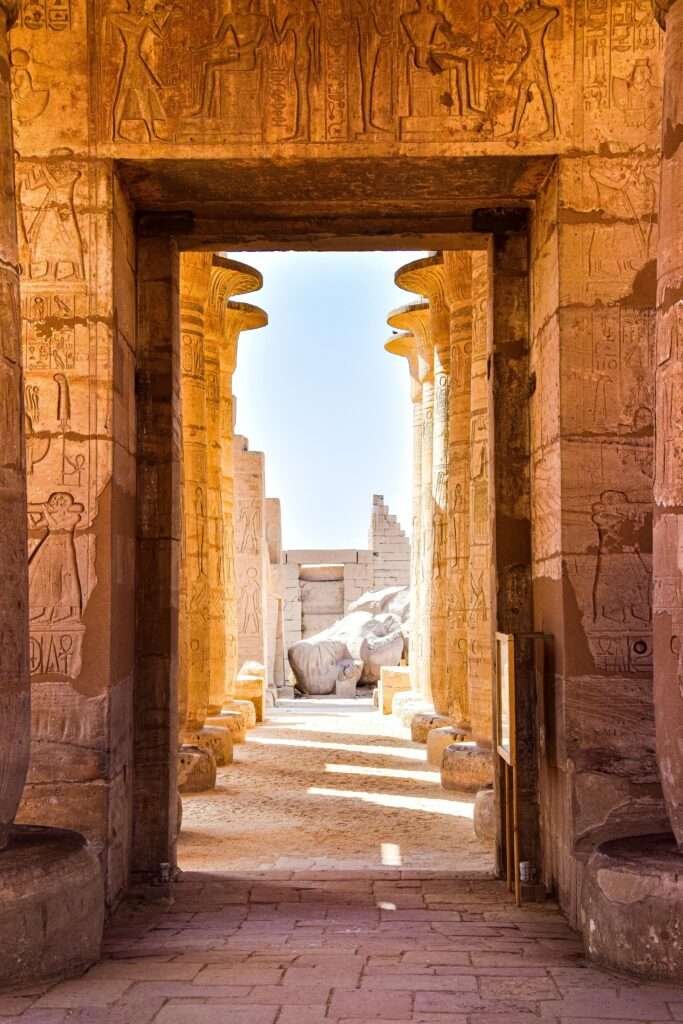
Egypt: Journey to the Land of Pharaohs
Imagine yourself in Egypt, a land where ancient mysteries meet modern wonders, where time seems to stand still.
The remnants of a glorious past are waiting to be explored. Egypt is a country that never fails to mesmerize travellers with its rich history, stunning landscapes, and vibrant culture.
Whether your destination of choice is Cairo, Luxor or beyond, Egypt offers an unforgettable adventure for those seeking to uncover the secrets of this magnificent nation.
In this blog, we’ll take you on a journey through the wonders of Egypt and highlight the places you must visit.
Cairo, the capital of Egypt
Located on the banks of the Nile, Cairo is Egypt’s bustling capital and the perfect starting point for your Egyptian adventure.
For thousands of years, the Nile has been the lifeblood of Egypt. Its annual inundation brought fertility to the land, allowing the ancient Egyptians to cultivate crops and thrive. Today, this majestic river remains the cornerstone of Egyptian culture, sustaining communities, agriculture, and a way of life deeply rooted in tradition.
By following the path of the Nile, travellers can unlock the mysteries of the pharaohs and explore the customs and traditions of the local communities. The Nile serves as a gateway to a world of archaeological wonders and timeless heritage.
Here, you can explore the iconic Giza Plateau, home to the pyramids of Giza, including the Great Pyramid of Khufu, the last remaining wonder of the ancient world.
The Great Pyramid of Khufu, also known as the Pyramid of Cheops, is a colossal structure that continues to captivate the imagination of travellers and historians alike. Built over 4,500 years ago during the Fourth Dynasty of the Old Kingdom of Egypt, this pyramid was the tallest man-made structure in the world for over 3,800 years! Here’s what makes it truly special:
- Engineering Marvel: The precision and engineering skill displayed in the construction of the Great Pyramid are nothing short of astonishing. The alignment, symmetry, and level of craftsmanship are a testament to the advanced knowledge of the ancient Egyptians.
- Mysterious Origins: The Great Pyramid is shrouded in mystery, with many questions still unanswered. How were the massive stones transported and precisely positioned? What was the purpose of the inner chambers and corridors? These enigmas continue to fuel speculation and intrigue.
- Cultural Significance: The pyramid holds immense cultural significance, serving as a tomb for Pharaoh Khufu (also known as Cheops). It’s a vivid representation of ancient Egyptian beliefs in the afterlife and the divine nature of their rulers.
- Ageless Wonder: The fact that the Great Pyramid has endured millennia of history, including earthquakes, erosion, and various civilizations, makes it a symbol of endurance and timeless beauty. It’s a connection to the distant past, a tangible link to an era that shaped the course of history.

Steigenberger Hotel El Tahrir Cairo
Among Cairo hotels, Steigenberger El Tahrir secures a spectacular location in El Tahrir Square, overlooking the Egyptian museum, minutes away from Khan El Khalili Bazar, and in close proximity to Egypt’s major attractions with a total area of 21,633 sqm

Pyramids Land Inn
Situated in Cairo, 1 km from Great Sphinx, Pyramids Land Inn features accommodation with a garden, free private parking, a terrace and a restaurant. Ideally situated in the Giza district, this hotel offers a bar. The accommodation provides a 24-hour front desk, airport transfers, room service and free WiFi throughout the property.

Kempinski Nile Hotel, Cairo
Get the celebrity treatment with world-class service at Kempinski Nile Hotel, Cairo
Located in Cairo’s affluent Garden City district, Kempinski Nile Hotel offers luxurious rooms on the shores of the Nile River. It features a wellness centre and a rooftop swimming pool.
Egypt ‘s Giza Plateau: A Sacred and Mysterious Landscape
Beyond the Great Pyramid of Khufu, the Giza Plateau hosts two other remarkable pyramids – those of Khafre and Menkaure – forming a stunning trio that continues to baffle and inspire. The plateau, with its ancient temples, tombs, and the enigmatic Sphinx, offers a unique blend of history, spirituality, and wonder. Here’s what makes the Giza Plateau an extraordinary destination:
- Ancient Astronomical Significance: The pyramids’ precise alignment with celestial bodies and their role in ancient Egyptian astronomy add a layer of mystique to the plateau. Scholars believe that the layout of the pyramids may have had a celestial or religious significance.
- The Sphinx: Guardian of Secrets: The enigmatic Sphinx, with the body of a lion and the head of a pharaoh, stands sentinel at the Giza Plateau. Its true purpose and the riddles it might hold continue to intrigue scholars and visitors alike.
- Cultural Immersion: Walking through the Giza Plateau is like stepping into the heart of ancient Egypt. The grandeur of the pyramids and the historical relics surrounding them offer an unparalleled opportunity for cultural immersion and a deep appreciation of the country’s rich heritage.
The Giza Plateau and the Great Pyramid of Khufu are not just iconic landmarks; they are windows into the distant past, showcasing the brilliance of ancient civilizations and their cultural legacy. The mysteries, the grandeur, and the enduring allure of this site make it a truly special destination. When you stand in the shadow of the Great Pyramid, you’re not just witnessing history; you’re experiencing the magic of the ancient world in all its splendour.

The Sphinx of Giza: Unveiling the Mysteries of Egypt
The Sphinx of Giza, an enigmatic guardian with the body of a lion and the head of a pharaoh, is a captivating and intriguing figure that has fascinated travelers, scholars, and explorers for centuries. What is it about the Sphinx that makes it so endlessly interesting? Let’s delve into the factors that contribute to its unique allure.
1. Symbol of Majesty and Power: The Sphinx represents the potent fusion of a powerful lion, symbolizing strength, and the head of a pharaoh, symbolizing royal authority. This iconic image epitomizes the might and majesty of ancient Egypt, the land of the pharaohs.
2. Age and Endurance: Believed to have been constructed during the reign of Pharaoh Khafre in the 26th century BC, the Sphinx stands as a testament to the enduring legacy of ancient Egyptian civilization. It has weathered over 4,500 years of history, natural elements, and human interaction, adding an element of timelessness to its intrigue.
3. Purpose and Mystery: One of the most intriguing aspects of the Sphinx is its purpose. The exact reasons for its creation remain shrouded in mystery. While some believe it served as a guardian to protect the nearby pyramids and temples, others suggest it held a deeper, more spiritual significance. The Sphinx’s true role continues to be a subject of scholarly debate and exploration.
4. Riddles and Legends: The Sphinx is not only a physical monument but also a figure associated with riddles and legends. The most famous of these is the Riddle of the Sphinx, a tale from Greek mythology in which the Sphinx posed a challenging riddle to travellers. Those who couldn’t solve it faced dire consequences. This rich history adds an element of intrigue and mystique to the monument.
5. Geological Origins: The Sphinx was carved from a single limestone outcrop, and its construction required immense skill and precision. Understanding how the ancient Egyptians quarried, transported, and sculpted such massive stones continues to be a topic of exploration and fascination.
6. Celestial Alignments: Some scholars believe that the layout of the Giza Plateau, including the Sphinx and the nearby pyramids, may have had astronomical significance. The alignment of the Sphinx with certain celestial bodies adds a layer of intrigue for those interested in ancient astronomy and mysticism.
7. Cultural and Spiritual Significance: The Sphinx’s presence at the Giza Plateau enhances the spiritual atmosphere of the site. It was positioned near the temples and pyramids associated with the afterlife, underscoring its role in ancient Egyptian religious beliefs. Its connection to the cycle of life and death adds depth to the understanding of Egyptian culture.
In summary, the Sphinx of Giza is captivating due to its remarkable blend of power, age, purpose, and enduring mysteries. It stands as a symbol of the grandeur of ancient Egypt, a guardian of the past, and a timeless enigma that continues to beckon explorers, historians, and dreamers from all over the world. Whether you’re drawn to its historical significance, its enigmatic aura, or its majestic presence, the Sphinx remains a captivating icon that embodies the essence of ancient Egypt’s rich and enduring legacy.

The Egyptian Museum: A Journey into the Heart of Ancient Egypt
The Egyptian Museum in Cairo is a treasure trove of antiquities, a repository of history, and a portal to the fascinating world of ancient Egypt. For anyone with a thirst for knowledge and a love of history, here’s what makes the Egyptian Museum an unmissable and captivating destination:
1. World’s Largest Collection of Egyptian Artifacts: The Egyptian Museum boasts an awe-inspiring collection of over 120,000 ancient artefacts, including precious treasures, statues, jewellery, and mummies. It’s a veritable time capsule of Egypt’s rich history and culture, spanning over 5,000 years.
2. Tutankhamun’s Glorious Treasures: Among the museum’s highlights is the astonishing collection of treasures from the tomb of King Tutankhamun. This young pharaoh’s golden mask, jewellery, and funerary artefacts are renowned worldwide for their opulence and artistry, offering visitors a glimpse into the wealth and splendour of ancient Egyptian royalty.
3. Unparalleled Historical Significance: The museum is home to historical milestones such as the Rosetta Stone, which played a pivotal role in deciphering hieroglyphics, and the mummies of ancient pharaohs, which offer insights into the mummification process and the beliefs surrounding the afterlife.
4. Immersive Experience: Walking through the museum’s vast halls, you can immerse yourself in the daily lives, customs, and traditions of ancient Egyptians. The diverse collection, including everyday items and religious artefacts, helps recreate the world of the past, giving visitors a profound sense of connection with ancient civilizations.
5. Architectural Marvel: The museum itself is a historical gem, with its neoclassical architecture and grand design. The building, constructed in 1902, exudes an air of history and reverence, making it the perfect setting for these ancient treasures.
6. Ongoing Discoveries: The museum is not a stagnant entity; it is a living institution where new discoveries are continuously made. Archaeological excavations throughout Egypt continue to contribute to the museum’s ever-evolving collection, offering visitors the opportunity to witness history in the making.
7. Educational Value: For students, history enthusiasts, or anyone keen to learn, the Egyptian Museum provides a rich educational experience. Its exhibitions, guided tours, and knowledgeable staff offer valuable insights into the mysteries and marvels of Egypt’s past.
8. Sense of Connection: Visiting the Egyptian Museum is like stepping back in time and connecting with the people who lived in this ancient land. Whether you’re fascinated by the art, the religion, or the daily life of the Egyptians, the museum allows you to forge a deep and personal connection with this extraordinary civilization.
The Egyptian Museum in Cairo is a captivating destination that beckons visitors from around the world with its unparalleled collection of artefacts and its ability to transport them to the fascinating world of ancient Egypt. It’s a place where history comes alive, mysteries are unravelled, and the enduring legacy of one of the world’s most iconic civilizations is celebrated. A visit to this museum is not just a journey into the past; it’s an exploration of the human spirit, ingenuity, and the profound desire to leave a mark on the sands of time.

Khan el-Khalili Market: A Shopper’s Paradise and Cultural Oasis in the Heart of Cairo
If you’re a traveller seeking a vibrant and immersive experience, Cairo’s Khan el-Khalili Market should be at the top of your itinerary. This bustling marketplace is more than just a shopping destination; it’s a sensory journey into Egyptian culture and a vibrant hub for handcrafted goods. Let’s explore what makes Khan el-Khalili a must-visit for shoppers and culture enthusiasts alike.
1. Timeless Souk with a Rich History: Khan el-Khalili has been a thriving market for centuries. Its roots can be traced back to the 14th century when it was established as a major trading hub for merchants. This historical significance permeates every alley and shop, making it a living testament to Egypt’s past.
2. Authentic Egyptian Souvenirs: From colourful textiles and intricately designed carpets to hand-blown glassware and brass lanterns, Khan el-Khalili offers a wide array of handcrafted goods. Visitors can take home authentic souvenirs that reflect Egypt’s rich artistic heritage and craftsmanship.
3. A Feast for the Senses: Wandering through the maze-like lanes of Khan el-Khalili, you’ll encounter a cacophony of sounds, a kaleidoscope of colours, and a medley of aromas. Street vendors selling fragrant spices, sizzling kebabs, and sweet pastries create an intoxicating atmosphere that’s sure to entice your senses.
4. Jewelry and Precious Stones: For jewellery enthusiasts, Khan el-Khalili is a treasure trove. The market is renowned for its jewellery shops offering stunning pieces crafted from semi-precious stones, such as lapis lazuli, turquoise, and vibrant coral. You can find unique, handcrafted jewellery items that tell a story of Egypt’s rich cultural heritage.
5. Traditional Egyptian Crafts: Khan el-Khalili is a hub for skilled artisans who craft beautiful, traditional items. Look out for the intricate woodwork, copperware, and Egyptian perfumes made from time-honoured recipes. These crafts are not just products; they are expressions of Egypt’s cultural identity.
6. Immersive Cultural Experience: Strolling through Khan el-Khalili is like taking a journey into local life. Engage with the friendly shopkeepers, who are more than willing to share their stories and insights about their crafts. You’ll have the opportunity to not only purchase unique goods but also connect with the people who create them.
7. Historical Landmarks: Khan el-Khalili is not just a market; it’s a neighbourhood filled with historical landmarks. As you explore, you’ll come across notable sites like the Al-Hussein Mosque, an important religious centre, and the picturesque Naguib Mahfouz Café, named after the Nobel laureate and a hub for literature enthusiasts.
8. Unique Architecture: The market’s architecture is a fusion of various styles, reflecting the influence of different periods in Egyptian history. The arches, domes, and intricate designs on buildings add to the overall ambience, making the market itself a visual feast for architecture enthusiasts.
Khan el-Khalili Market is a microcosm of Egypt’s rich culture, history, and craftsmanship. It’s not just a shopping destination; it’s a cultural experience that immerses you in the heart of local life. Whether you’re hunting for souvenirs, appreciating traditional crafts, or simply soaking in the vibrant atmosphere, a visit to Khan el-Khalili is a must for those who seek a deeper connection with the culture and people of Egypt. It’s a bustling, centuries-old market where every step offers a new discovery, making it an unforgettable part of any Egyptian adventure.

.
Luxor: Where Ancient Wonders and Modern Comforts Coexist
When it comes to captivating destinations that seamlessly blend ancient history, archaeological treasures, and modern amenities, Luxor in Egypt stands out as a shining gem. This city is not just a place; it’s an experience waiting to be lived. Let’s explore what makes Luxor so interesting and why it’s a must-visit destination for travellers seeking to uncover the mysteries of Egypt’s past.
1. The World’s Greatest Open-Air Museum: Luxor is often referred to as the “world’s greatest open-air museum,” and for a good reason. It’s home to some of the most iconic and well-preserved ancient Egyptian monuments, including the Luxor Temple, Karnak Temple, and the Valley of the Kings. These remarkable sites transported visitors to a time when pharaohs ruled, gods were worshipped, and grand civilizations thrived.
2. Valley of the Kings: The Valley of the Kings, located on Luxor’s West Bank, is a breathtaking archaeological site where many pharaohs, including Tutankhamun, were laid to rest in elaborately decorated tombs. Exploring these richly adorned tombs is like stepping into the afterlife, where ancient beliefs and rituals come to life through intricate wall paintings.
3. Luxor Temple: Luxor’s city centre boasts the Luxor Temple, an architectural masterpiece dedicated to the rejuvenation of kingship. It’s a magical place, especially when illuminated at night, offering an opportunity to witness the blending of ancient and modern times.
4. Karnak Temple Complex: The Karnak Temple Complex is a sprawling, awe-inspiring site that showcases the grandeur of ancient Egyptian architecture and religious practices. Its massive columns, intricate hieroglyphs, and sacred lakes make it a must-see destination for history enthusiasts and photographers.
5. Nile River Cruises: A Nile River cruise from Luxor is a dream come true for many travellers. Cruising along the Nile’s tranquil waters, you can enjoy stunning views of the riverbanks, visit temples and ruins that can only be reached by boat, and experience the beauty of Egypt’s landscapes from a unique perspective.
6. Modern Comfort and Hospitality: While Luxor is steeped in history, it offers the comfort of modern amenities. The city has a range of accommodations, from luxury hotels to budget-friendly options, ensuring that you can explore ancient wonders during the day and relax in comfort at night.
7. A Bridge to Ancient Civilization: Luxor acts as a bridge to the heart of ancient Egypt. It’s a city where you can immerse yourself in the culture, connect with locals, and delve into the mysteries of a civilization that has left an indelible mark on the world.
8. The Hot Air Balloon Experience: For a unique perspective of Luxor and its historical sites, consider a sunrise hot air balloon ride. Drifting above the city and the Nile, you’ll witness a breathtaking panorama of the temples and tombs beneath you.
Luxor is a destination that combines the best of ancient history and modern comfort. It’s a place where you can walk in the footsteps of pharaohs, explore temples dedicated to gods, and witness the magic of ancient Egypt while enjoying contemporary conveniences. Luxor is an invitation to journey back in time and experience a world of wonders that continues to captivate the imagination of travellers from around the globe. If you seek history, culture, and awe-inspiring experiences, Luxor is a destination you won’t want to miss.

Steigenberger Nile Palace Luxor – Convention Center
Get the celebrity treatment with world-class service at Steigenberger Nile Palace Luxor – Convention Center
This Steigenberger hotel is situated in the heart of Luxor and provides modern accommodation with stunning views of the Nile.

Pavillon Winter Luxor
Pavillon Winter Luxor offers 3 restaurants, 2 bars, and warm hospitality in the heart of Luxor city. It overlooks the River Nile and is just 100 metres away from the Luxor Temple.
Rooms and suites are comfortably furnished and include private, furnished balconies with views of the garden.
Pavillon Winter Luxor offers a large outdoor swimming pool surrounded by palm trees and exotic plants.

Sofitel Winter Palace Luxor
A stunning example of Victorian architecture, this prestigious hotel is a short walk from Luxor Temple and features high-standard facilities.
Sofitel Winter Palace Luxor has a history of hosting royalty and celebrities throughout the years. The interior features grand staircases, high ceilings and lounge areas that are appointed with antique furniture and beautiful flower arrangements.
Aswan: Nubian Culture and Tranquil Beauty
Nestled along the Nile River, Aswan is a captivating destination that offers a unique blend of natural beauty and cultural richness. Here’s why you should be enticed to visit Aswan:
1. Philae Temple: A Testament to Ancient Mastery: The Philae Temple, dedicated to the goddess Isis, is an architectural marvel that seamlessly integrates history and spirituality. Carved out of the surrounding rock, it was relocated to its current island home to save it from being submerged by the construction of the Aswan High Dam. Exploring this temple is like stepping back in time and marvelling at the craftsmanship of ancient architects.
2. Nubian Culture and Heritage: Aswan is your gateway to experiencing the vibrant Nubian culture. The Nubian people have a rich heritage and are known for their unique traditions, colourful clothing, and warm hospitality. A visit to a Nubian village will introduce you to their way of life, their language, and their captivating music and dance.
3. Tranquil Nile River: A leisurely felucca ride on the Nile is an experience you won’t forget. It’s a chance to bask in the serenity of the river, surrounded by picturesque landscapes and timeless beauty. The slow, quiet pace of the ride allows for relaxation and reflection, making it a highlight of any visit to Aswan.
4. Elephantine Island: A Glimpse into Nubian Life: Elephantine Island, situated in the Nile, offers a deeper insight into the Nubian way of life. Stroll through the island’s charming streets, interact with the locals, and discover their unique customs. The Nubian Museum on the island provides a fascinating overview of Nubian history, making it a cultural and educational delight.
5. The Nubian Market: Aswan is also home to a bustling Nubian market where you can find vibrant fabrics, intricate crafts, and traditional Nubian products. It’s the perfect place to shop for souvenirs that reflect the local culture and artistry.
6. The Stunning Nubian Desert: Aswan’s surroundings aren’t just about the Nile; they also encompass the captivating Nubian Desert. Explore the arid landscape, discover ancient rock art, and witness the stark beauty of the desert, which provides a striking contrast to the lushness of the river.
7. Ethereal Sunsets: Aswan is renowned for its breathtaking sunsets. The play of colours over the Nile and the surrounding landscapes creates a surreal, almost otherworldly experience. Watching the sun dip below the horizon is a mesmerizing ritual that shouldn’t be missed.
Aswan is more than a destination; it’s a gateway to a world where history, culture, and nature come together in harmony. Whether you’re exploring ancient temples, immersing yourself in Nubian traditions, or simply soaking in the tranquillity of the Nile, Aswan offers a unique and enriching travel experience. It’s a place that captures the essence of Egypt’s cultural diversity and natural beauty, making it an unmissable addition to your travel itinerary.

Abu Simbel: The Temples of Ramses II – A Journey into Ancient Splendor
Tucked away in the Nubian desert, near the border with Sudan, the temples of Abu Simbel await visitors with their magnificent grandeur and historical significance. These temples, commissioned by one of Egypt’s most iconic pharaohs, Ramses II, are not just monuments; they are portals to the past, offering a captivating glimpse into the power, artistry, and culture of ancient Egypt. Here’s what to expect when visiting Abu Simbel:
1. Colossal Statues: The first sight that will leave you awestruck as you approach Abu Simbel are the colossal statues that guard the entrance to the temples. Four massive figures of Ramses II, each standing at a towering 20 meters (over 65 feet) in height, dominate the facade. Their detailed features, including the pharaoh’s iconic double crown, are a testament to the artistic and engineering prowess of ancient Egypt.
2. Sunlight Alignment: One of the most remarkable aspects of Abu Simbel is its precise alignment with the sun. On two specific days of the year, February 22 and October 22, the morning sunlight penetrates the temple’s inner sanctuary to illuminate the statues at the far end. This solar phenomenon is a testament to the ancient Egyptians’ astronomical knowledge and their deep connection with the sun god, Ra.
3. Temple of Ramses II: The larger of the two temples is dedicated to Ramses II himself. Inside, you’ll find a series of grand halls and chambers adorned with intricate hieroglyphics, reliefs, and depictions of military victories and divine offerings. A highlight is the sanctuary, which houses a colossal seated statue of Ramses II and a depiction of the goddess Hathor.
4. Temple of Hathor and Nefertari: The smaller temple at Abu Simbel is dedicated to Ramses II’s beloved wife, Queen Nefertari, and the goddess Hathor. It’s a testament to the strong role of women in ancient Egypt. The temple’s interior is decorated with depictions of Nefertari and Hathor, and it’s a stunning example of ancient Egyptian artistry.
5. Preservation Efforts: A significant part of the Abu Simbel story is the relocation of the temples in the 1960s to save them from the rising waters of Lake Nasser, following the construction of the Aswan High Dam. The impressive relocation project is a testament to modern engineering, and the temples remain in remarkable condition.
6. Visitor Experience: Visitors to Abu Simbel can explore both temples, taking in the colossal statues, intricate carvings, and well-preserved interior chambers. The temples’ stunning architectural design and historical significance make it a must-visit for history enthusiasts, Egyptologists, and travellers looking to witness the enduring legacy of ancient Egypt.
7. A Remote Oasis: Abu Simbel’s remote location in the Nubian desert adds to its mystique. While it requires a bit of effort to reach, the journey through the desert landscapes is part of the adventure. The serene surroundings and the isolation from modern life contribute to the temples’ aura of timelessness.
Abu Simbel is a profound testament to the achievements of ancient Egypt and the enduring legacy of Ramses II. When visiting Abu Simbel, expect to be transported back in time, to stand in the presence of colossal statues, and to marvel at the artistry and engineering of an ancient civilization. It’s a journey that provides a deep appreciation for the
Alexandria: Where History Meets the Mediterranean – A Seaside Gem in Egypt
Nestled on the picturesque Mediterranean coast, Alexandria is a city that beckons travellers with its unique blend of history, culture, and the serene beauty of the sea. It’s a destination that offers a different side of Egypt, one that captivates visitors with its coastal charm and remarkable historical landmarks. Here’s why Alexandria is truly a wonder waiting to be explored:
1. The Catacombs of Kom El Shoqafa: Step into the depths of history at the Catacombs of Kom El Shoqafa. This underground necropolis is a testament to the multicultural heritage of Alexandria, where you can explore ancient tombs adorned with a fusion of Egyptian, Greek, and Roman art and architecture. The catacombs are a captivating journey into the past, a place where the boundaries of different civilizations blur.
2. Pompey’s Pillar: Pompey’s Pillar, a towering monolith, is a striking testament to the grandeur of ancient Alexandria. It’s not just a column; it’s a symbol of the city’s historical significance. Standing tall at over 26 meters, it’s an awe-inspiring sight and a must-visit for history enthusiasts.
3. Qaitbay Citadel and the Pharos Lighthouse: The Qaitbay Citadel, majestically perched on the Mediterranean shoreline, is a medieval fortress that transports you to a time of battles and conquests. What makes it truly special is its location, believed to be the site of the legendary Pharos Lighthouse, one of the Seven Wonders of the Ancient World. The view from the citadel is breathtaking, offering a vista of sea and sky that has inspired countless poets and artists over the centuries.
4. Seaside Strolls along the Corniche: Alexandria’s Corniche, a scenic promenade along the Mediterranean, invites leisurely strolls, with the sound of waves and the fresh sea breeze as your companions. As you walk, you’ll pass charming cafes, seafood restaurants, and inviting parks. The view of the sea is a calming balm for the soul, and the sunsets are nothing short of magical.
5. Fresh Seafood Delights: Alexandria is renowned for its seafood. As you savour a meal of freshly caught fish, shrimp, or calamari at one of the local seafood restaurants, you’re indulging in a culinary experience that reflects the city’s maritime heritage. The flavours are as vibrant as the setting, making every meal a memorable one.
6. Library of Alexandria: For those with a love of knowledge, the modern Library of Alexandria is a must-visit. It pays homage to the ancient Library of Alexandria, which was one of the most comprehensive libraries of the ancient world. The modern library is a hub of education, culture, and enlightenment, with stunning architecture and a vast collection of books and resources.
7. Cultural Fusion: Throughout its history, Alexandria has been a melting pot of cultures and civilizations. Greek, Roman, Egyptian, and Arab influences have left their mark, creating a unique tapestry of traditions, architecture, and cuisine. It’s a city that embodies the harmonious coexistence of diverse cultures.
In conclusion, Alexandria is a city that weaves together the threads of history and the beauty of the Mediterranean, creating an experience that is as diverse as it is captivating. It’s a place where history meets the sea, where ancient wonders stand alongside modern culture, and where the coastal charm adds a unique dimension to your exploration of Egypt. Alexandria is a wonder that invites you to immerse yourself in its timeless allure, where history and the Mediterranean breeze are forever intertwined in a harmonious dance.

The Red Sea: Underwater Wonders – Explore a Vibrant Subaquatic Eden
A visit to the Red Sea is a journey into a world that seems almost otherworldly, a realm where vibrant marine life and breathtaking coral reefs create an underwater paradise that beckons travellers from across the globe. Here’s why the Red Sea is a truly special destination and why you’ll want to experience its underwater wonders:
1. Spectacular Coral Reefs: The Red Sea is home to some of the world’s most spectacular and thriving coral reefs. The vibrant colours and intricate formations of these reefs are a sight to behold, providing a mesmerizing backdrop for divers and snorkelers. The reefs are teeming with life, from tiny, colourful fish to graceful sea turtles, making each dive or snorkelling session an adventure in itself.
2. Pristine Waters: The Red Sea is known for its crystal-clear waters, providing excellent visibility for divers and snorkelers. Under the surface, you’ll find a world of astounding clarity, where every detail of the underwater landscapes comes to life. This makes it an ideal destination for both beginners and experienced divers.
3. Diversity of Marine Life: The Red Sea is a biological hotspot, offering an impressive diversity of marine species. From the graceful movements of manta rays to the curious behaviour of dolphins and the elusive seahorses, you’ll encounter a fascinating array of underwater creatures. It’s a place where you can witness nature in all its glory.
4. Historical Shipwrecks: In addition to natural wonders, the Red Sea also holds the secrets of the past. The region is dotted with historical shipwrecks that have become artificial reefs. These sunken vessels tell stories of maritime history and serve as unique dive sites for explorers looking to uncover the mysteries of the deep.
5. Thrilling Diving and Snorkeling Sites: The coastal cities of Hurghada and Sharm El-Sheikh serve as gateways to the Red Sea’s underwater treasures. Whether you’re an experienced diver or a novice snorkeler, there are sites for every level. For divers, sites like Ras Mohammed National Park and the Thistlegorm Wreck offer unforgettable experiences. Snorkelers can explore the coral gardens right from the shore.
6. Family-Friendly Activities: The Red Sea’s gentle currents and shallow reefs make it a family-friendly destination for snorkelling and introductory diving. It’s a place where parents and children can bond over the thrill of discovering a new world beneath the waves.
7. Stunning Natural Backdrops: The Red Sea’s coastal landscapes, with their golden sands and rugged mountains, provide a picturesque setting for your underwater adventures. Whether you’re on a boat heading to a dive site or simply lounging by the shore, the natural beauty of the region is a feast for the eyes.
In conclusion, the Red Sea is not just a destination; it’s an invitation to explore a subaquatic wonderland that few places on Earth can rival. Its pristine waters, kaleidoscopic reefs, and diverse marine life make it a must-visit for divers, snorkelers, and nature enthusiasts. The Red Sea offers a chance to witness the magic of the underwater world, where tranquillity and adventure converge, and where the vibrant colours and mysteries of the deep blue sea promise an unforgettable experience. It’s a destination that reminds us of the incredible beauty and biodiversity our planet has to offer, and it’s an opportunity to connect with the natural world in a truly special way.
Historical Marvels and Timeless Beauty
Egypt’s historical treasures are world-renowned, and it’s no wonder. The Great Pyramids of Giza, the Sphinx, and the temples of Luxor stand as a testament to a civilization that flourished thousands of years ago. Exploring these ancient wonders is like taking a journey back in time. Each corner of Egypt tells a unique story, making it an ideal destination for history enthusiasts and adventure seekers alike.
Egypt is a land of enchantment where history, culture, and natural beauty combine to create a captivating travel experience. From the iconic pyramids of Giza to the tranquil beauty of Aswan, the historical treasures of Luxor, the grandeur of Abu Simbel, the Mediterranean charm of Alexandria, and the underwater wonders of the Red Sea, Egypt offers an endless array of attractions for every traveller.
So, pack your bags and prepare to embark on a journey through time in this land of pharaohs, where the past and present coexist in a harmony that’s uniquely Egyptian. Your adventure begins in Egypt, where wonders never cease and memories last a lifetime. Come and experience the magic of Egypt for yourself!
Packing for Egypt:
Packing for a trip to Egypt requires consideration of the country’s climate, culture, and the activities you plan to engage in. Here’s a list of essential items to pack:
- Light Clothing: Egypt’s climate is generally hot and dry, especially in the summer months. Pack lightweight, breathable clothing like t-shirts, shorts, and sundresses. However, it’s important to dress modestly when visiting religious sites, so also bring long-sleeve shirts and pants or long skirts.
- Swimwear: If you’re planning to visit the Red Sea, bring swimwear for snorkelling and beach activities.
- Sun Protection: Egypt is known for its intense sun, so pack sunscreen, sunglasses, a wide-brimmed hat, and a swimsuit cover-up for added sun protection.
- Comfortable Shoes: Comfy walking shoes are essential for exploring historical sites and markets. If you plan to go hiking, consider packing appropriate footwear.
- Travel Adapters: Egypt uses the Europlug (Type C and Type E) socket. Bring suitable adapters for your devices.
- Power Bank: An external charger or power bank is handy for keeping your devices charged while on the go.
- Hydration: A reusable water bottle is essential. Make sure to drink plenty of water, especially in the hot weather.
- Travel Documents: Ensure you have your passport, visa, and any required permits. Make photocopies of important documents and keep them separate from the originals.
- Medications: If you have prescription medications, bring an ample supply, along with a copy of your prescription. Include a basic first-aid kit with items like pain relievers, stomach remedies, and band-aids.
- Local Currency: While you can exchange money in Egypt, it’s a good idea to bring some Egyptian pounds (EGP) with you to get started.
Local Customs and Etiquette in Egypt:
Understanding and respecting local customs is crucial when visiting Egypt. Here are some important cultural norms and customs to keep in mind:
- Modest Dress: Egypt is a conservative country, especially in rural areas and when visiting religious sites. Dress modestly by covering your shoulders and knees. For women, a headscarf may be required when visiting mosques.
- Greeting Customs: A common greeting is “As-salaam alaykum” (peace be upon you). It’s polite to return the greeting with “Wa alaykum as-salam” (and peace be upon you).
- Respect for Religion: Egypt is predominantly Muslim, and it’s important to be respectful of Islamic customs. When visiting mosques, remove your shoes, and be mindful of prayer times. Avoid discussing sensitive religious or political topics.
- Haggling: Bargaining is common in Egypt, especially in markets and souks. Negotiating prices is expected, so don’t hesitate to haggle.
- Use Right Hand: When eating or giving and receiving items, use your right hand, as the left hand is considered less clean.
- Tipping: Tipping is a common practice in Egypt, especially for service industry workers like tour guides, drivers, and restaurant staff. Be prepared to tip, and consider keeping small bills for this purpose.
- Photography: Always ask for permission before taking photos of people, especially in rural areas. In some tourist sites, there may be fees for photography.
- Public Displays of Affection: It’s considered inappropriate to engage in public displays of affection, especially in rural areas. Keep physical contact modest.
- Ramadan: During the month of Ramadan, when Muslims fast from sunrise to sunset, it’s polite to refrain from eating, drinking, or smoking in public during daylight hours, out of respect for those who are fasting.
- Language: While Arabic is the official language, English is widely spoken in tourist areas. Learning a few basic Arabic phrases can go a long way in showing respect for the local culture.
By being aware of and respecting these customs and norms, you’ll ensure a more enjoyable and culturally sensitive visit to Egypt, where you can appreciate the rich heritage and warm hospitality of the Egyptian people.



